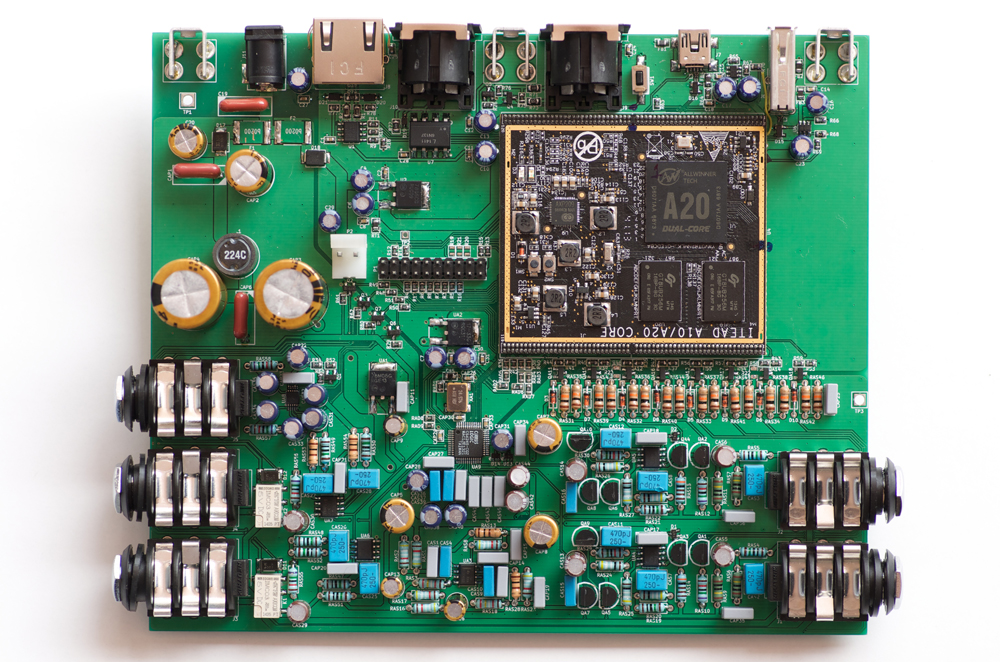This is a testimonial from Rafael Guayer, our Hardware Design Engineer and Barbecue Manager.
It was a great challenge to develop a soundboard from scratch. After working with ultrasound frequencies, where the sampling frequencies reached 80MHz, I thought it would be easy, but it wasn’t that simple. Sampling and reproducing sound is not only about physics and engineering specifications. It has a subjective approach, for the nuances of sound are highly human-dependent. In these digital times we are looking back to some old analog concepts. It’s like the parallel between the CD and vinyl, and silicon amplifiers and tube ones.
The MOD audio processing is all digital. We wanted the most “analog-ish” sound conversion and we wanted the sound to be warm and colorful, but most of all we wanted to satisfy an “audiophile ear”. So we started digging into some concepts to reach the best balance between the digital and analog domains, and also to make an economically viable product. It wasn’t easy at all!
The first piece of the puzzle was the domains converter, the analog to digital (ADC) and the digital to analog (DAC) converters. We chose an external audio codec from the renowned manufacturer Cirrus Logic, which is known to produce great sound converters. Here we faced some challenges like poor documentation and support, and the fact that there was no driver available for the chosen codec.
Being a multi-purpose device, and thus, multi-instrument, the MOD needs an input circuit that adapts the different electrical characteristics of each instrument to match the ADC. Normally in this kind of equipment you see push buttons and other switches used to toggle different input impedances. But it is known that these mechanical devices can introduce sound artifacts and that their contacts don’t last forever .
An engineering and design task was in our hands - we had to develop a flexible impedance input with no mechanical components that was digitally controlled directly from the soundboard driver. The solution was an impedance bridging circuit based on internal switches that changes the resistor network directly connected to our input. Here we faced the dilemma of using modern switches that would make our life easier. But instead of using small and cheap CMOS switches, despite its great engineering specifications, we’ve chosen to use discrete JFET switches, which are less complicated silicon components and more suitable for audio.
Then we came into the black magic of passive components. How could capacitors and resistors with the exact same specifications sound so different? Here the sky was the limit, I mean, our pocket was the limit! At higher costs, we are using only components that are known for their sound quality. We use only metal film resistors, and metal film and special electrolytic capacitors. We don’t use any resonating surface mount component in the soundboard. And we are experimenting with many different brands to get the best trade-off between quality, availability and price. It’s a pleasant surprise to see how different these components sound.
We took extra care in choosing the operational amplifiers and their topologies. Even the sound decoupling voltage bias is an active filter, not only a voltage divider.
The layout of the printed circuit of our soundboard was treated like a baby. A bad layout can ruin a great project, so the small sound signal path was carefully routed, and we ended with a great quality sound device.
We’ve made a prototype that sounds great. We’re working now with the release candidate product and we are sure that it’ll sound even better. We are still experimenting some solutions but we already have the initial specifications of our soundboard:
MOD DUO’s Sound Board Initial Technical Specs
AUDIO CONNECTIONS
2 independent inputs
- 1/4′ TS connectors
- Digital input impedance selector | line / microphone / instrument
- Programmable Gain Amplifier: ± 12 dB Gain, 0.5 dB step plus a 32 dB gain stage for microphone
2 independent outputs
- 1/4′ TS connectors
- Volume Control: 0 to -127 dB, 0.5dB step
Headphone output
- 1/4′ stereo connector
- Digital volume control from +12dB to −33dB
Neutrik® connectors
True Bypass circuit
INPUT IMPEDANCES
- Instrument: 500kΩ.
- Line: 75kΩ.
- Microphone: 3kΩ.
AUDIO CODEC
- Manufacturer: Cirrus Logic
- DAC: 104dB Dynamic Range. -90dB THD+N
- ADC: 104dB Dynamic Range. -95dB THD+N
- 24 bit / 48 kHz AD/DA
HEADPHONE AMPLIFIER
- Manufacturer: Texas Instruments
- Class AB Amplifier
- THD+N at 1kHz, 105mW continuous average output power into 16Ω: 0.1%
- THD+N at 1kHz, 70mW continuous average output power into 32Ω: 0.1%
CPU
- Dual Core ARM A7 1.0GHz
- Dual/Quad Core ARM A7 1.5GHz (Stretch Goal)
- 1GB RAM - 4GB Flash Storage
CONTROLLER
- 2 knobs with LCD screen
- 2 foot switches with color LEDs
I/O CONNECTIONS
- MIDI IN connector – DIN 5 pins – for musical instruments and controllers
- MIDI OUT connector – DIN 5 pins
- Control-Chain – RJ-45 – for additional controllers
- USB HOST - USB 2.0 Standard-A type
- USB Bluetooth
- USB Wifi
- USB MIDI
- USB DEVICE - USB 2.0 Standard-B type
- USB Ethernet Adaptor
- USB Audio 2.0 (Stretch Goal)
We are still improving the soundboard and we need your help with this crowd funding project so we can make the best sound quality available in MOD Duo.

